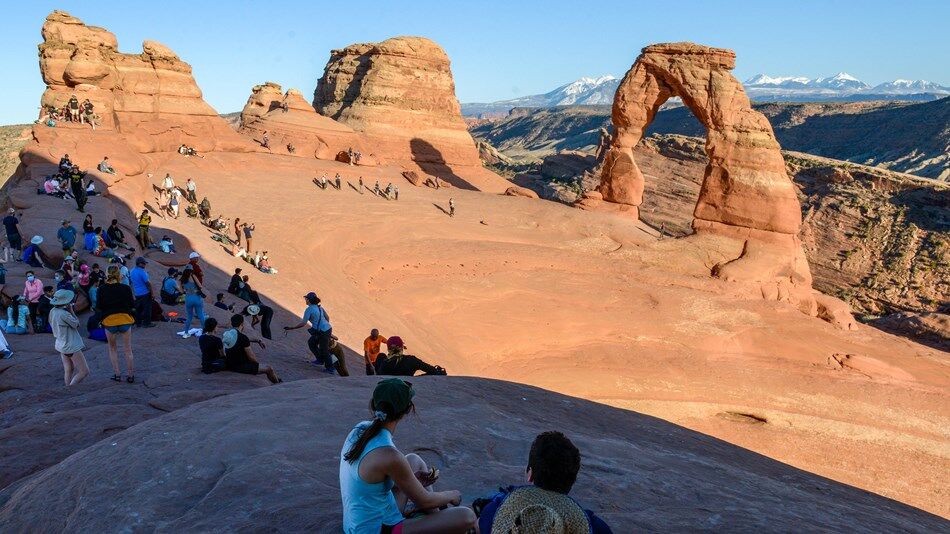Some information may be outdated.
At 1 p.m. on the first day of the pilot timed-entry system at Arches National Park, the line of cars at the entrance station stretched about a third of the way back along the road between the highway and the gate. Rangers in orange vests screened cars ahead of the fee booth:
“Do you have a reservation? Do you have your confirmation? Do you have a valid I.D.?”
Visitors were encouraged to have all items ready to help move the creeping line along as quickly as possible. Several cars had to u-turn out of the left lane after talking with the screening ranger—perhaps they hadn’t known about the timed entry system, which was advertised on a variable-message sign along Highway 191.
The timed entry reservation system is the National Park Service’s attempt to address overcrowding in Arches National Park. From 2009 to 2019, visitation to Arches grew by over 66%. During popular times, parking lots were full, trails and overlooks were crowded, and the line to enter the park sometimes backed up traffic on Highway 191. Park officials began temporarily closing the gates when parking lots reached capacity, and visitors who showed up at the wrong time were turned away.
The timed-entry approach has been used in sections of other national parks, like Yosemite, Glacier, Rocky Mountain and Acadia. Visitors make a reservation ahead of time to enter the park during a specific hour on a specific date, and there are a limited number of slots for each hour. The idea has been discussed for years between Arches National Park and the local community, with staunch opposition from some stakeholders in past years. But the increasing swell of tourism changed many minds, and eventually the concept gained enough support for the park to implement a pilot this season. The Arches system only applies from April through early October, from 6 a.m. to 5 p.m. daily.
At the booth, rangers seemed relieved when they met with visitors who had followed all instructions. Drivers with the correct reservations, identification, and payment were given a brochure marked with a sticker to indicate to the next orange vest-clad ranger that they should be allowed in. Drivers on the inside lane without reservations were directed to circle the round-a-bout just inside the gate and exit the park.
While it felt a little like a military checkpoint, the line moved at a reasonable pace and led to a wide-open parking lot at the visitor center. There were no lines for the restroom, and kids were able to explore the exhibits inside free of crowds.
The parking lot at the trailhead to Delicate Arch, the most iconic feature in the park, was busy, but not full—an open parking spot appeared on the first circle through the lot. There were dozens of hikers in sight from any point on the trail, but they weren’t elbow to elbow. Only at the narrowest sections did people have to wait for hikers going the opposite direction to pass.
The day was breezy and slightly overcast, but the view of the arch from the slickrock bowl above was clear and majestic. Groups of visitors sat on the rim looking down on it while having a snack; a line formed near the arch where people took turns posing underneath for pictures. Canny ravens hopped and flapped at a safe distance, watching for dropped morsels.
It was far from a solitary experience, but there was no crushing pressure from an anxious crowd. The density of people felt similar to what it had been on another visit to Arches this year—in February. In 2021, about three and a half times as many people visited the park in April as in February. June usually sees the most visitors, but the whole stretch between March and October is a popular time to visit.
Dozens of comments on the Arches National Park Facebook page remarked on the new system. Many posters were nostalgic for memories of quieter days at the park, while also acknowledging the need to address today’s crowds and grateful to park managers for taking action. Some described enjoying the park under the timed entry system more than they had in years. In response to one commenter’s professed heartbreak at the new system, Arches National Park responded,
“The ability to be spontaneous at Arches has been diminished for years due to overcrowding. Before the timed pilot entry, the park closed nearly everyday in the busy season. With timed entry, visitors have reliable access.” The response went on to note that 25% of each day’s reservations become available the day before the date of entry to accommodate last-minute plans.
This year is only a test-run of the system. “Data collected over the duration of the temporary pilot program will help determine timed entry’s viability as a longer-term traffic and congestion solution,” the park’s website says. “If the pilot is a success, timed entry may be implemented in the future as a component of a larger visitor use plan.”
Appreciate the coverage? Help keep local news alive.
Chip in to support the Moab Sun News.





